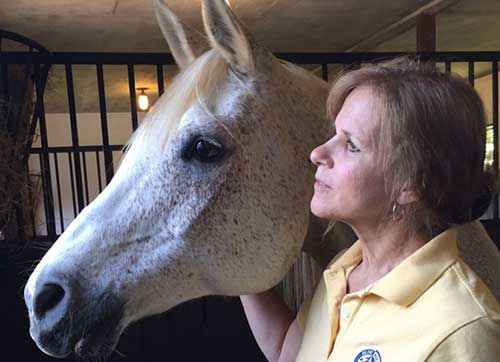
by Jen Roytz
We’ve all heard the saying “You can lead a horse to water, but you can’t make them drink.” Horses have to be thirsty in order to consume water, and the lynchpin in that scenario is salt.
Dehydration in horses–or any animal–can quickly escalate from mild to catastrophic. Their internal environment is water-based, and salt is the driving force behind the regulation and distribution of water in and out of cells.
“Salt is 39% sodium and 61% chloride. When consumed, salt will split in the body into the separate minerals to be used independently (as electrolytes),” said Dr. Kathleen Crandell, PhD, a nutritionist with Kentucky Equine Research (KER). “Both these minerals have independent roles in the body, but mainly they work together balancing fluid movement in and out of the cells and acid-base balance, as well as electrical impulse conduction in nerves and muscles. Further, sodium is needed for transport of substances across cell membranes, like glucose.”
The more a horse exercises and sweats, the more water they need to consume to prevent dehydration, and as such the more salt they require in their diet. While forage, grass and concentrated feeds contain salt, it is not enough to adequately meet a horse’s dietary needs, especially a high-performance equine athlete, such as a racehorse, making proper salt supplementation key.
“Increasing supplementation to match increases in sweating will help the horse keep from getting dehydrated. The other stage in life with the highest salt requirement is during lactation,” said Crandell. “Furosemide (Lasix) can affect salt requirements–horses regularly administered furosemide have increased salt intakes as well as water intakes. This is because furosemide increases excretion of sodium and chloride as well as water. In studies, ponies administered furosemide daily almost tripled their ad-lib salt intakes over the study period.”
Typically, a horse weighing 1,100 lbs. (500 kg) in light work would require 1-1.75 oz. (30-50 grams), or roughly two tablespoons, of salt per day for maintenance. Much like a horse’s caloric needs increase with added workload, so too does their need for salt. However, unlike excess calories, which can be stored in the body in the form of fat, excess salt is eliminated in the urine.
It is thought that if given free-choice access to salt, a horse in light to moderate work will eat enough to meet its own requirement.
“Profound sweating or strenuous work can increase a horse’s salt needs up to 120 grams (4.25 oz.) per day,” said Sven Hanson, Chairman of Salinity Group, a global company specializing in the sourcing and distribution of salt for agricultural, industrial and culinary purposes, among others. The company also produces several salt products specifically formulated for horses. Their most popular is the Equisalt Advantage salt lick, which contains selenium, biotin, vitamins, copper, cobalt and iron in addition to salt.
There are several options available to horse owners to meet a horse’s salt needs, including electrolyte supplements, salt blocks and table salt. According to Crandell, horses will consume more salt when offered loose than in block form, and horses will drink more water when consuming loose salt.
“Non-iodized white salt is usually a good choice for horses,” said Crandell. “Whether to use a salt that is combined with other minerals depends on the diet of the horse. If a horse has no other source of iodine, then iodized white salt is appropriate. Mineralized salt is appropriate for horses on a forage-only diet and not receiving the minerals from anywhere else. A mineralized salt block formulated for horses is superior over other types of livestock salt, such as yellow blocks (salt and sulfur), blue blocks (salt, cobalt and iodine) or red blocks (salt, iodine and iron). The classic brown trace mineral block formulated for livestock that may come with or without selenium is not the ideal salt block for horses because the actual amounts of minerals other than sodium and chloride are very low and horses would need to over-consume the salt to get enough minerals to meet their requirements.”
Hanson, who, with his wife Carina, has bred and owned racehorses for years, including multiple Group 1 winner Reliable Man and Champion Pride, says horse owners need to be mindful about what salt block or supplement is right for a horse based on its size and workload.
“A 1 kg (2.2 lbs.) salt lick should last a normal horse roughly about a month for maintenance, if it’s not gone in a month and the horse isn’t supplemented in another way, the horse needs salt in some other form, such as pure salt in their feed,” said Hanson. “Horses that work hard and sweat a lot need salt supplementation. Many commercial electrolytes are too low in NaCl content, so one should always check what those electrolytes really contain and do not be afraid to give a horse some pure salt in conjunction with hard exercise.”
This article originally appeared on The Thoroughbred Daily News and is published here with permission. Find out more about caring for your horse in our section on Health & Education.

































